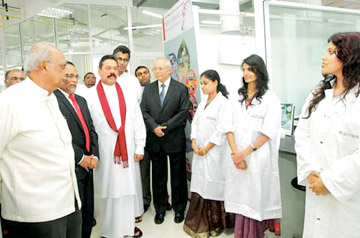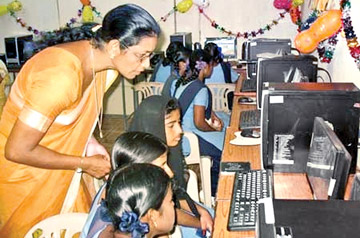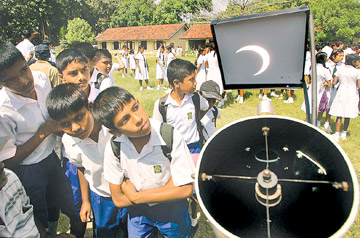|
7,200 research scientists by 2016:
Science and technology in the forefront of development
By Dhaneshi Yatawara
 |
| President
Mahinda Rajapaksa at SLINTEC |
 |
| Equal
opportunities for all |
 |
| Creating a
science enthusiastic future generation |
The week dedicated to science ended with the World Science Day
celebrations on November 10. How many of us noticed the importance of it
other than few programs at schools?
Sri Lanka is struggling to get out of the middle income trap fighting
against the turmoils in the world economy. Countries with several
similarities to Sri Lanka made successful breakthroughs by thinking out
of the box. Many of these countries, such as Korea, Thailand heavily
relied on science and technological inventions.
Today the poverty gap between the countries is due to the
technological gap. Science and technology boost revenue in the world.
Attitudes
In a rapidly advancing world, every citizen needs to be adequately
equipped with the latest knowledge to engage intelligently in public
dialogue and debate about important issues of the society from
genetically modified food to energy options, safety of food, water and
environment and nuclear energy. It is the responsibility of the
authorities to ensure adequate scientific literacy among its people.
An attitudinal change would be the foundation from which knowledge
empowerment and rapid economic-take-off towards a knowledge based
economy could occur. If our products cannot be sold then our enterprises
will collapse and we will be defeated in the economic battle.
Innovations
"Sri Lanka hopes for not only a per capita income boost but a
different economic status too. An innovation driven economy implies
internal innovations and an excellent national competitiveness in a
global marketplace. Science and technology play a significant role in
this transition. Having mere expectations with any type of activity will
not deliver this situation.
It is not easy to be an innovative economy," said Project Director of
the Coordinating Secretariat for Science, Technology and Innovation (COSTI),
Prof. Ajith de Alwis, a recently established state entity mandated with
coordinating and monitoring scientific affairs.
The Coordinating Secretariat for Science, Technology and Innovation (COSTI)
was set up on February 1, 2013 as mandated by the cabinet decision of
September 9, 2011 with the aim of coordinating and monitoring science,
technology and innovation activities in the country. It will also work
towards promoting value addition and commercialisation in line with the
National Science Technology and Innovation (STI) Strategy of Sri Lanka
approved by the Cabinet in August 2010.
A key goal of the COSTI will be to coordinate and monitor the
planning, preparatory and implementation stages, linkages with science
centres and other relevant organisations abroad and subsequent
monitoring the functioning of the National Science Centres. The COSTI
reports to the Inter-Ministerial Committee on Science, Technology and
Innovation.
At this time in the history when Asia is becoming a formidable
economic power we too should recognise the importance of science,
technology and innovation in fuelling a national economy.
To raise Sri Lanka to a developed status the science and technology
Policy along with others must be integrated with other inputs such as
infrastructure transport, telecommunications, power, etc., a fair and
efficient legal system, including law enforcement, and above all peace
and security.
National development can only be achieved in an environment in which
individuals have faith in the system and feel comfortable investing in
productive enterprises.
New chapter
Implementing the Mahinda Chinthana vision for the future, the
Research and Development Ministry has taken measures to increase the
number of research scientists and technologists in Sri Lanka to 7,200 by
2016.
Currently there are about 4600 research scientists and it is not
sufficient to battle the economic war. The Ministry hopes to establish a
full time research cadre in the universities and absorb 500 personnel
per year.
According to statistics available with the Ministry of Technology and
Research, Sri Lanka has nearly 30 research institutes under nine
ministries and around 48 university faculties.
Research
Over 50 percent of the research and development institutes are in the
Western province while the second highest number is in the Central
province. Out of those in the Central Province, over 90 percent are
dedicated to agriculture research and development work.
The statistics indicate that nearly 50 percent of the State research
institutes are dedicated to agricultural research and development while
only five are dedicated to industrial research and development and two
for health. Accordingly, the Sri Lankan university system consists of 78
science-related faculties with 425 departments with science laboratories
in 16 state universities.
On the direction of Minister of Technology and Research, Patali
Champika Ranawaka the Ministry in collaboration with the National
Science and Technology Commission, formulated the '10 x 10' Investment
Framework for research and Development for 2015-2020. This initiative is
aimed at achieving ambitious expectations from the science, technology
and innovation sector preceded with a plan that targets national
needs.Accordingly, the framework identifies ten national priority areas
and ten intervention methodologies - hence the title '10 x 10'
Investment - i.e. focuses on water, food /nutrition /agriculture,
health, shelter, energy, textile industry, environment, mineral
resources, information/ communication technology / knowledge services
and basic sciences / emerging technologies / indigenous knowledge. The
ten interventions are policy studies, pure and applied research,
innovations, information and communication, technology, nanotechnology,
biotechnology, indigenous knowledge and intellectual property rights,
testing and standardisation, capacity building, popularisation.
New policy
All institutions under the Ministry of Technology and Research - The
National Science and Technology Commission (NASTEC), National Science
Foundation (NSF), Industrial Technology Institute (ITI), Arthur C.
Clarke Centre for Modern Technologies (Clarke Centre), National
Engineering Research and Development Centre (NERD), Institute of
Fundamental Studies (IFS), National Research Council (NRC), Sri Lanka
Standards Institute (SLSI) and the Sri Lanka Accreditation Board for
Conformity Assessment (SLAB) and the Sri Lanka Inventors Commission,
have been directed to formulate plans after studying the national policy
documents which are the Budget speech for 2011, the Science and
Technology Policy, the 5-year Science, Technology and Innovation
Strategy and the 10-year policy framework in the Mahinda Chinthana
Vision for the future.
This will ensure that all these institutions will focus on
identifying activities that will contribute to national development
objectives and thereby to economic development. Requests for funding
such activities can then be justified.
Every individual needs to use scientific knowledge to make choices
for themselves that arise everyday, from health and nutritional issues
to resilience to disasters.
Unfortunately for Sri Lanka the public perception of science and
technology is one of sheer indifference. The majority of Sri Lankans,
including policy makers and the younger generation have not yet changed
their mindset about the direct involvement of science and technology in
national development. Given the high literacy and relatively high per
capita income compared to other countries in the region, Sri Lanka lacks
a science culture due to the lack of understanding of science and
technology and innovations. |

